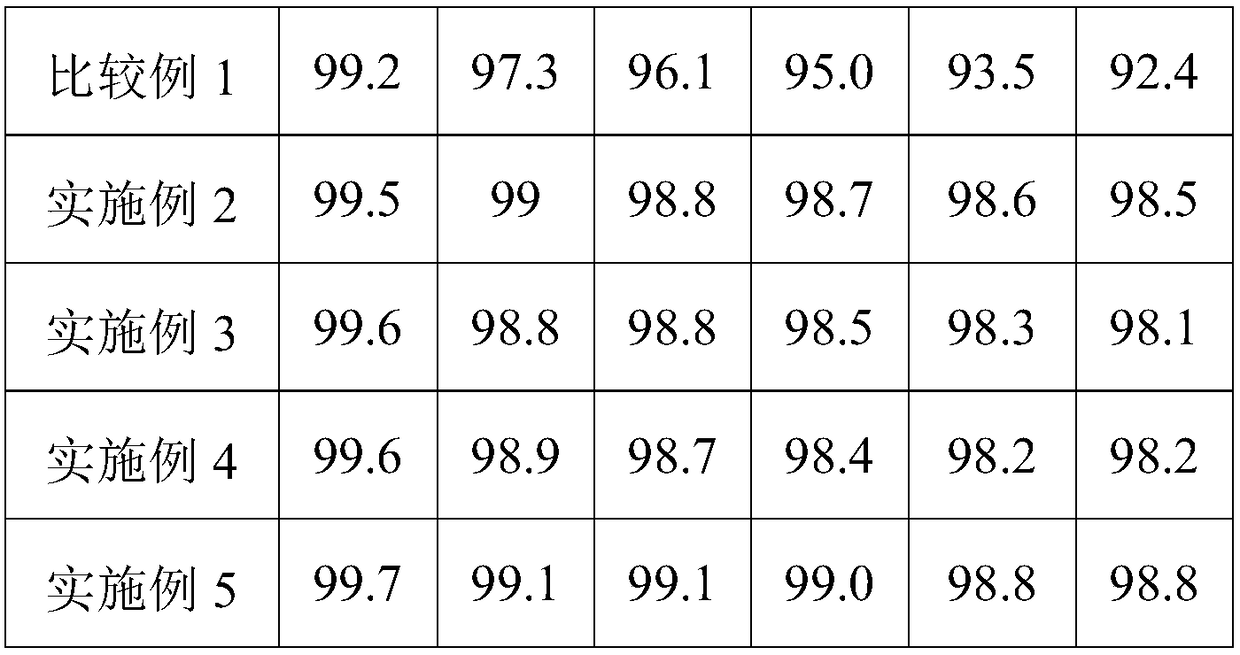Chlorine-resistant reverse osmosis composite membrane and preparation method thereof
A reverse osmosis composite membrane, chlorine-resistant technology, applied in the direction of reverse osmosis, semi-permeable membrane separation, chemical instruments and methods, etc., can solve the problems of shortened life, increased operating costs, and reduced membrane performance, so as to improve the service life and excellent Chlorine resistance, effect of reducing attack sites
- Summary
- Abstract
- Description
- Claims
- Application Information
AI Technical Summary
Problems solved by technology
Method used
Image
Examples
Embodiment 1
[0021] Immerse the polysulfone microporous membrane in an m-phenylenediamine aqueous solution with a mass percentage of m-phenylenediamine of 2%, take it out, remove the excess solution on the surface with a rubber roller, and then immerse it in an aqueous solution with a mass percentage of trimesoyl chloride. Take it out after at least 1 min in the n-hexane tricarboxylic acid chloride solution, heat treatment at 75°C for 5 min, and form an aromatic polyamide separation layer on the surface of the polysulfone microporous membrane; then immerse the polysulfone microporous membrane with the aromatic polyamide separation layer on the surface Activate in an aqueous solution of formaldehyde with a mass percentage of 0.1%, after activation, immerse in an aqueous solution of polyvinyl alcohol with a mass percentage of 0.2% for at least 5min, take it out and dry it in the shade, and then immerse it in a glyoxal with a mass percentage of 1 % glyoxal aqueous solution for at least 1 min, ...
Embodiment 2
[0025] Immerse the polysulfone microporous membrane in an m-phenylenediamine aqueous solution with a mass percentage of m-phenylenediamine of 2.5%, take it out, remove the excess solution on the surface with a rubber roller, and then immerse it in an aqueous solution with a mass percentage of trimesoyl chloride of 1.5%. Take it out after at least 1min in the n-hexane tricarboxylic acid chloride solution, heat treatment at 80°C for 4min, and form an aromatic polyamide separation layer on the surface of the polysulfone microporous membrane; then immerse the polysulfone microporous membrane with the aromatic polyamide separation layer on the surface Activate in an aqueous solution of acetaldehyde with a mass percentage of 0.6%. After activation, immerse in an aqueous solution of sodium alginate with a mass percentage of 0.5% for at least 5 minutes. Take it out after 1.2% glutaraldehyde aqueous solution for at least 1 min, heat treatment at 80°C for 4 min, cross-link on the surface...
Embodiment 3
[0027] Immerse the polysulfone microporous membrane in an m-phenylenediamine aqueous solution with a mass percentage of m-phenylenediamine of 3%, take it out, remove the excess solution on the surface with a rubber roller, and then immerse it in an aqueous solution with a mass percentage of trimesoyl chloride. Take it out after at least 1 min in the n-hexane tricarboxylic acid chloride solution, heat treatment at 85°C for 3 min, and form an aromatic polyamide separation layer on the surface of the polysulfone microporous membrane; then immerse the polysulfone microporous membrane with the aromatic polyamide separation layer on the surface Activation is carried out in an aqueous solution of propionaldehyde with a mass percentage of 5% propionaldehyde, after activation, immersed in an aqueous solution of sodium lignosulfonate with a mass percentage of 0.2% sodium lignosulfonate for at least 5 minutes, taken out and dried in the shade, then immersed in glutaraldehyde Take it out f...
PUM
| Property | Measurement | Unit |
|---|---|---|
| salt rejection rate | aaaaa | aaaaa |
Abstract
Description
Claims
Application Information
 Login to View More
Login to View More - R&D
- Intellectual Property
- Life Sciences
- Materials
- Tech Scout
- Unparalleled Data Quality
- Higher Quality Content
- 60% Fewer Hallucinations
Browse by: Latest US Patents, China's latest patents, Technical Efficacy Thesaurus, Application Domain, Technology Topic, Popular Technical Reports.
© 2025 PatSnap. All rights reserved.Legal|Privacy policy|Modern Slavery Act Transparency Statement|Sitemap|About US| Contact US: help@patsnap.com


